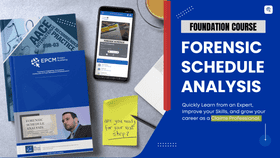
Forensic Schedule Analysis Foundation Course Watch Preview
“Small daily – seemingly insignificant – improvements and innovations lead to staggering achievements over time.”
— Robin S. Sharma —
This course will be available only for 7 days; after that, the access will be closed. Every day new lessons will be unblocked. If you complete it, at the end of the course, you will receive a certificate of achievement with 2 PDU or 0.20 CEU and a special gift for your time and dedication to learning more every day.
Mr. Mark Sanders participated in developing both AACE’s and ASCE’s guidelines for Forensic Scheduling. In this course, he will teach you the fundamentals of Forensic Schedule Analysis.
Whether or not you have previous knowledge about Forensic Schedule Analysis, this course will help you understand the fundamentals: What is it? And Why do we do it?.
Many professionals with experience believe in knowing how to apply the methods; however, they usually have mistakes in their analysis, mixing methods, and finally, they do a wrong analysis.
So, everyone needs to understand all of the forensic techniques that are currently available, how these techniques arose, where they came from, and why. And then understand how and when to apply them in each situation.
23 Lessons
Day 1

1. Introduction
Introduction to Forensic Schedule Analysis

2. Overview
Overview of Forensic Schedule Analysis

3. Basic Concepts
Learn the Basic Concepts of Commitment, Plan, Forecast and Result

4. Why we do a Forensic Schedule Analysis
Learn Why are we performing a Forensic Schedule Analysis
Day 2

5. What is Forensic Schedule Analysis?
Learn about of What is Forensic Schedule Analysis

6. What events or deviations merit investigation?
Learn in short really what events merit investigation

7. Delay analysis before CPM, 19th-20th Century
Learn about evolution of Delay Analysis before the Critical Path Method.
Day 3

8. The birth of CPM (1950s)
Learn about evolution of Delay Analysis when Critical Path Method arose.

9. Early Case Law in CPM Delay Analysis (1960s -1070s)
Learn how Delay Analysis evolve in the 1960s

10. Legal Journal publicaction of CPM Delay Analysis Techniques (1970s - 1990s)
Learn how Delay Analysis evolve in the 1980s
Day 4

11. State of the art 2000s and beyond
Learn the current state of art of the Forensic Schedule Analysis

12. Current Consensus documents : AACE, SCL, ASCE
Learn about the current consensus documents related to Forensic Schedule Analysis as AACE International, SCL, ASCE

13. Basic principles of analysis: Contract & Law
Learn the basic principles of Contract and Law related to Forensic Schedule Analysis
Day 5

14. Basic principles of analysis: Planning & Scheduling
Learn the basic principles of Planning & Scheduling related to Forensic Schedule Analysis

15. Basic principles of analysis: Constructability
Learn the basic principles of Constructability related to Forensic Schedule Analysis

16. Basic principles of analysis: Delay to the Critical Path
Learn the basic principles of Delay and Critical Path Method related to Forensic Schedule Analysis
Day 6

17 Basic principles of analysis: Theories of Critically
Learn the basic principles of Theories of Critically related to Forensic Schedule Analysis

18. Basic principles of analysis: Float Ownership
Learn the basic principles of Float Ownership related to Forensic Schedule Analysis

19 Basic principles of analysis: Sequenece of Analysis
Learn the basic principles of Sequence of Analysis related to Forensic Schedule Analysis

20 Basic principles of analysis: Concurrency
Learn the basic principles of Concurency related to Forensic Schedule Analysis
Day 7

21. AACE Taxonomy of Forensic Analysis
Learn about AACE Taxonomy of Forensic Analysis methods

22. Key consideration prior to analysis
Learn about key consideration prior to delay analysis

23.Source Validation: Baseline, Updates, Documents, Fact Witnesses
Learn about the souce validation to perform the analysis as schedule baseline, schedule updates, documents, facts witnesses